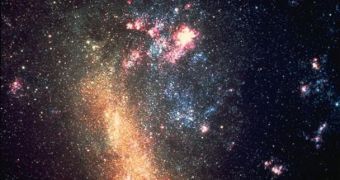Our galaxy, the Milky Way, is hanging out with a rather weird clique, astronomers say, referring to the cosmic structures that are closest to us – the Large and the Small Magellanic Clouds (LMC/SMC).
These peculiar formations re not necessarily galaxies, in the way the Milky Way and Andromeda are. Rather, they are very large clouds of stars, hydrogen gas and cosmic dust, called irregular galaxies.
At first glance, everything looks in order – we have a large galaxy surround by two smaller ones. But there is nothing normal, or common, about this image, experts say.
In fact, it is one of the rarest and odd configurations in the entire Local Group. Expert Sidney van den Bergh, who is based at the Herzberg Institute of Astrophysics, in Canada, recently completed an analysis of the formation.
First of all, he explains, the two companions our galaxy has are too young to have formed at the same time with the Milky Way. This idea is further strengthened by the fact that the two clouds appear to be passing through, rather than going in the same direction we are.
So the question of why do they accompany us follows. If this were a common occurrence, why can't we see companions around other galaxies such as Andromeda. Only a few Milky Way-class galaxies discovered thus far have companies, and those are usually dwarf galaxies.
These small formations tend to get sucked in by larger ones, and fuse with them. The Milky Way is believed to have consumed a large number of such structures in the not-too-distant past.
Another interesting aspect to the whole situation is the fact that the Large Magellanic Cloud is very luminous for a structure of its type.
“In other words the Large Magellanic Cloud seems to be close to the upper luminosity limit for irregular galaxies,” van den Bergh explains, quoted by Technology Review.
To get an idea of how rare our galactic setup is, consider that the Sloan Digital Sky Survey (SDSS) thus far analyzed no less than 22,581 galaxies. Of these, more than 81 percent had no satellites.
About 11 percent had one of them, and only 3.5 percent of all had two companions. “That the Galaxy should have an irregular companion as luminous as the Large Magellanic Cloud is almost a miracle,” the team leader explains.
Interestingly, the analysis indicates that one of the key tenets of the Copernican principle is wrong. The theory holds that we live on an average planet, in an average corner of the Universe.
However, it would appear that this is not the case, at least as far as our galactic setup is concerned. Astronomers will now try to determine whether this has any influence on the way the Milky Way is organized.

 14 DAY TRIAL //
14 DAY TRIAL //